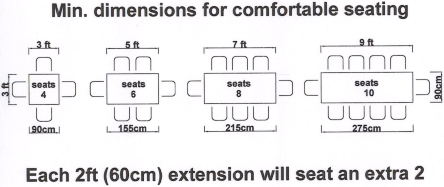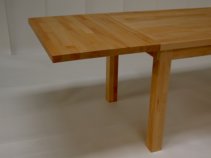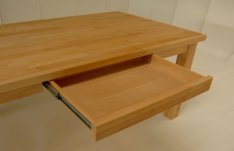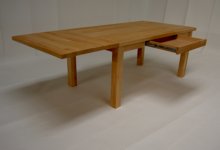 Shopping basket
Shopping basket

|
Design Assistant The following information is best practice when designing a table and is for guidance only. You are in no way required to follow it when customising your table design. A Persons Space Requirements At a minimum a person requires around 600cm (ca. 2ft.) in width not considering any table legs that may reduce this space and 35cm (ca.1ft-2“) in depth. Dining Table Height We recommend a dining table height of 76cm (30 in.) which gives you 65cm (25 in.) of leg space between floor and table frame. You may choose to size up to 79cm (31 in.) if there are no kids and you are taller than 188cm (6ft 2“) or if you choose unusually high chairs of 50cm plus (20 in.). Normal chair seating height varies between 45 to 50cm (ca.18 to 20 in.). Coffee Table Height All our table designs are easily adaptable for very nice coffee tables. Dimensions vary greatly in height between 20 to 50cm (8 to 20 in.) and are really more a personal choice in terms of how to dimension them. A standard coffee table tends to be 90Lx60Wx40H cm (3ftL x 2ftW x 1.3ftH). However we recommend you consider the following. Do not dimension a coffee table higher than the adjacent couch or armchair seating height and leave at least 30cm (1ft) of space between coffee table and couch for easy access. Room Layout When considering the size of your dining table please make sure you leave enough space for people to pass by a seated person as they may wish to get up during dinner. The example below gives you an indication of minimum space requirement around a table. Example: Your dining room is 500x300cm and has one door on the shorter wall that swings open 100cm. Substract 2x 100cm in each direction and an extra 100cm for the door. and your maximum table size is 500cm minus 2x100cm minus100cm for door = 200 long 300cm minus 2x100cm = 100 wide These dimensions may vary depending on the chairs being used and the layout of your dining area. Also consider fixed items such radiators and doors swinging open and the overall proportion of the room in relation to the table itself. Tip ! : Lay-out some newspaper on the floor which will give you a good idea of how big the table should be. Proportions If design is important to you then the proportions of your table should be important to you. Tables tend to look best in a ratio of 2:1 (length to width). However, this ratio may not always suit your requirements. Table Top Thickness Our tables come with a 40mm (1 ¾ inch) top which makes for good looks and solid construction. Leg Sizes With most of our tables designs we give you a choice of different leg sizes from 8x8 cm to 12x12cm. Most people prefer the thick chunky 12x12cm legs which work for almost all table designs no matter what size. However this does not apply for the thinner legs like 8x8. Please use these only on smaller tables (max 150 x 90cm), otherwise these thinner legs will look out of proportion. Inch to cm Conversions 1cm equals 0.39 inches 2.54cm equals 1 inch .
Drawers Our table drawers come in a standard width of 60cm (24in.) and a depth of 40cm (18 in.) which gives you Internal drawer measurements of: 56cm wide x 38cm deep x 6cm high (22in. wide x 15in. deep x 2.5in. high) All drawers are guided by ball-bearing easy-slide runners. Minimum table length required for a drawer is 124cm (49 inches). |







